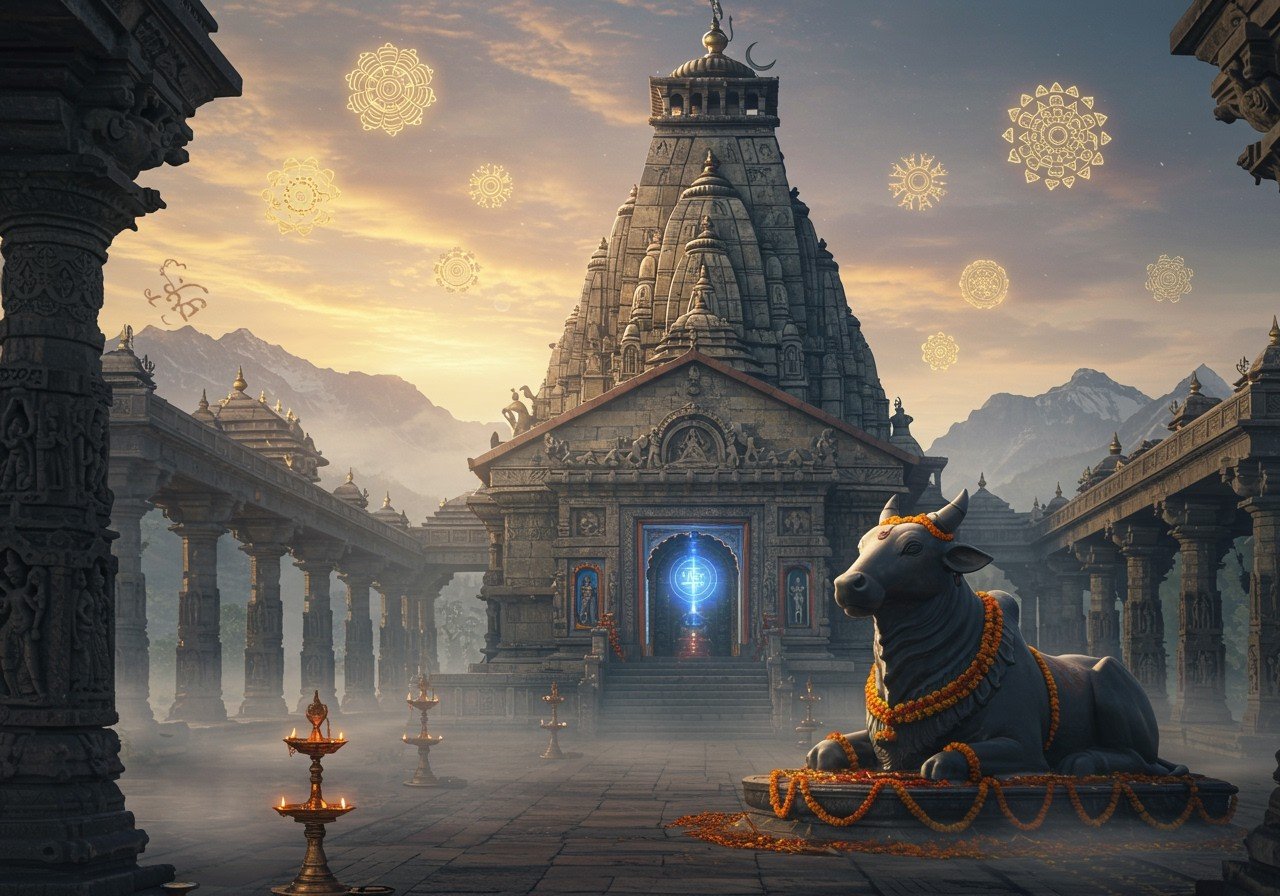
India, a land of vibrant spirituality, is dotted with countless temples dedicated to revered deities. Among them, the temples of Lord Shiva, the destroyer of ignorance and embodiment of cosmic energy, hold a special place in the hearts of devotees. These sacred spaces aren’t merely structures of stone and mortar; they are living testaments to India’s rich cultural heritage, architectural brilliance, and deep-rooted devotion. Join us as we journey through time, exploring the magnificent ancient Shiva temples that grace our land.
Understanding the Divine Significance of Lord Shiva
Lord Shiva, a central figure in the Hindu trinity, embodies the cosmic cycle of creation, preservation, and destruction. More than just a deity, he represents the very essence of existence, the constant dance of energy that shapes our universe. His iconic symbols, the Trishul (trident) symbolizing the three fundamental qualities of nature, and the Damru (drum) representing the rhythm of creation, resonate with profound philosophical meaning. From his celestial abode on Mount Kailash to his powerful Tandava, the cosmic dance of creation and destruction, Lord Shiva’s presence permeates every aspect of Hindu cosmology.
Across India, devotees celebrate Lord Shiva through vibrant festivals like Maha Shivaratri, a night dedicated to overcoming darkness and ignorance. The reverence for Shiva transcends regional boundaries, with diverse worship practices reflecting the rich tapestry of local traditions. The Shivling, a symbolic representation of divine energy, serves as the focal point of worship, connecting devotees to the formless and eternal aspect of the divine.
A Pilgrimage Through Time: Ancient Shiva Temples of India
India is a treasure trove of ancient Shiva temples, each echoing with stories of devotion and architectural marvels. From the snow-capped Himalayas to the southern tip of Kanyakumari, these temples stand as silent witnesses to centuries of faith. The architectural styles vary across the country, with the Nagara style prevalent in the north and the Dravidian style characterizing the south. Royal dynasties, including the Cholas, Pallavas, and Chalukyas, have left their indelible mark, constructing grand temples that continue to inspire awe.
Stepping into these temples is like stepping back in time. The intricate carvings, vibrant murals, and towering structures narrate tales of ancient Indian society, mythology, and spiritual beliefs. Devotees from all walks of life converge at these sacred sites, seeking blessings and enriching their spiritual journey. Some of the most revered temples include the Kashi Vishwanath Temple in Varanasi, a spiritual hub on the banks of the holy Ganges, and the Brihadeeswarar Temple in Thanjavur, a UNESCO World Heritage Site showcasing the pinnacle of Chola architecture.
For a deeper understanding of the historical and spiritual significance of these temples, explore these insightful articles:
- Lord Shiva Temples in Maharashtra: Significance and History
- Ancient Shiva Temples of Maharashtra: A Journey Through Time
Unraveling the Enigma of the Oldest Shiva Temple
The quest to identify the oldest Shiva temple in India has intrigued scholars and historians for centuries. The Mundeshwari Temple in Bihar, believed to date back to 108 AD, presents a strong claim. Nestled in the Kaimur hills, this ancient temple holds immense historical and spiritual significance. The Kedarnath Temple, nestled high in the Himalayas, also boasts ancient origins, intertwined with captivating myths and legends. Another significant group of temples, the Pancha Bhoota Stalas, represent the five elements of nature and are revered as ancient centers of Shiva worship. These five temples, each representing Earth, Water, Fire, Air, and Space, offer a unique spiritual experience.
Archaeological discoveries play a vital role in unraveling the mysteries surrounding these ancient temples, helping to date them and understand their evolution over time. Ongoing restoration efforts ensure that these architectural marvels are preserved for generations to come, allowing future pilgrims to connect with India’s rich spiritual heritage. These temples not only serve as spiritual anchors but also foster regional identities and cultural pride, linking communities to their ancestral past.
The Enduring Cultural and Spiritual Influence of Shiva Temples
Beyond their religious significance, Shiva temples play a vital role in preserving traditional art forms, music, and dance, which are intricately woven into the fabric of temple rituals. These sacred spaces promote religious tolerance and unity, attracting visitors from diverse backgrounds who seek solace and inspiration in their serene atmosphere. Temple tourism also contributes significantly to local economies, supporting livelihoods through pilgrimage activities.
The timeless beauty and spiritual power of Shiva temples continue to inspire contemporary art, literature, and philosophical discourse. Many temples house ancient libraries, safeguarding valuable texts and preserving traditional knowledge systems for posterity. Moreover, the sacred groves surrounding these temples play a crucial role in maintaining ecological balance and protecting biodiversity, highlighting the interconnectedness of spirituality and nature.
Poojn.in: Your Spiritual Companion
At poojn.in, we understand the deep significance of connecting with the divine. Whether you seek to create a sacred space in your home or enhance your temple visits, we offer a wide selection of puja items and supplies to support your spiritual practices. Our curated collection includes:
- Pure copper Shiva Lingams like this one, ideal for home worship.
- Traditional Rudraksha malas in various sizes, known for their spiritual properties. Browse our collection to find the perfect mala for your practice.
- Premium quality Bilva leaves and Dhoop, essential offerings for Lord Shiva. Explore our range of high-quality puja samagri.
- Authentic Panchamrit ingredients, to prepare the sacred offering for abhishek rituals.
- Pure silver Abhishek items, adding a touch of purity to your worship. Find exquisite silver items on our website.
- Sacred thread (Janeu) for ritual ceremonies, symbolizing spiritual connection.
- Brass and copper Puja thalis for Shiva Abhishek, designed for convenience and aesthetic beauty.
We deliver these sacred items right to your doorstep across India, ensuring the purity and authenticity of each product through strict quality checks, adhering to Vedic standards.
For personalized guidance on selecting the right Shiva puja items or for bulk orders for temple ceremonies, please contact us:
- Phone: 03369029784
- WhatsApp: 9476142738
Visit www.poojn.in to explore our complete range of Shiva puja essentials. We offer secure packaging and timely delivery to maintain the sanctity of your spiritual practices.
Note: Prices and availability of items may vary. Please check the website for current details.
Conclusion: Embracing the Timeless Heritage
India’s ancient Shiva temples are not just places of worship; they are repositories of history, culture, and spiritual wisdom. They offer a profound glimpse into the past, showcasing the architectural brilliance and deep-rooted traditions that have shaped our civilization. From the intricate carvings of the north to the majestic gopurams of the south, these temples invite us on a journey of exploration and appreciation for the rich tapestry of India’s heritage.
As you embark on your own pilgrimage to these sacred sites, may you experience the divine presence of Lord Shiva and deepen your connection to India’s cultural legacy. Whether you’re drawn to the grandeur of the Brihadeeswarar Temple or the serene simplicity of the Gudimallam Temple, each step will bring you closer to understanding the timeless wisdom of our ancestors. By honoring these ancient temples, we honor the traditions and beliefs that continue to enrich our lives today. Take a moment to pause, reflect, and embrace the beauty of India’s Shiva temples, allowing their stories to inspire reverence and wonder within your heart.
Frequently Asked Questions about Ancient Shiva Temples
Where can I find authentic puja items for Lord Shiva? Poojn.in offers a wide selection of genuine puja items, delivered to your doorstep.
How many Shiva temples are there in India? India is home to thousands of Shiva temples, ranging from small village shrines to grand complexes in major cities.
Which is considered the oldest Shiva temple? While several temples claim ancient origins, the Mundeshwari Temple in Bihar is often cited as one of the oldest functional Hindu temples, dating back to around 108 AD.
What are some of the most famous ancient Shiva temples? India boasts many renowned Shiva temples, including the Brihadeeswarar Temple in Thanjavur, the Kedarnath Temple in Uttarakhand, the Somnath Temple in Gujarat, and the Ramanathaswamy Temple in Rameswaram.
Why are Shiva temples culturally significant? Shiva temples serve as vital cultural hubs, hosting community events, festivals, and rituals that foster social cohesion and preserve ancient traditions.
What is unique about ancient Shiva temple architecture? The architecture varies across regions, with distinct styles like Nagara in the north and Dravidian in the south. Intricate carvings, towering spires (shikharas), and elaborate sculptures are common features.
Can I visit these temples throughout the year? Most ancient Shiva temples are open year-round, though it’s advisable to check for specific festival dates or potential closures for maintenance.
What rituals are typically performed in Shiva temples? Common rituals include offerings of milk, water, flowers, and bilva leaves, along with the sacred Abhishekam bathing ritual. Devotees chant mantras and perform aarti, expressing their reverence and devotion.


